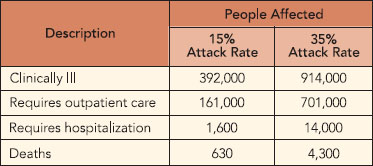
Thoughts on a Pandemic
1. "Our model predicts that a mild pandemic would reduce annual GDP [Gross Domestic Product] growth by 2 percentage points from what it would otherwise be. A severe pandemic, similar to the 1918 Spanish flu [2.5% of those infected died], would reduce global GDP growth by 6 percentage points."
Translation: In Canada, this would amount to lost annual GDP growth of between US$20 and US$60 B.
"It is important to remember that even with a severe pandemic, roughly 99% of the world’s population will survive."
From: Dr Sherry Cooper, Executive Vice President, BMO Financial Group and Chief Economist, BMO Nesbitt Burns. The Avian Flu Crisis: An Economic Update, March 2006.
2. The Bank of Canada estimated that Canada’s GDP shrank 0.6% in the quarter immediately following the SARS outbreak, a relatively contained event.
Almost 6 in 10 respondents said they would provide more compensation to employees who cover for absent colleagues, but no details were provided.
Employees have the right to refuse to perform work they believe is unsafe. Those working in direct contact with the general public face the greatest risk. "…a declaration by a health and safety officer that the workplace itself is unsafe would effectively shut down the operation." Fewer than half had a plan for this matter; most of those indicated they would simply follow safety legislation.
From: Conference Board of Canada, June 2006. A State of Unpreparedness: Canadian Organizations’ Readiness for a Pandemic.
3. Modelling Mortality and Morbidity for the City of Toronto

From: Toronto Pandemic Influenza Plan – A Planning Guide for Business, July 2006. page 6
4. At least one-third of deaths are likely to be in people under age 65 compared to less than 5% of deaths in inter-pandemic years.
Sub-clinical infections will occur. Based on previous pandemics, some people will only experience mild illness or have no symptoms, but still be able to transmit the virus to others. This will make case identification and contact tracing more difficult.
From: Government of Ontario, Ontario Health Plan for an Influenza Pandemic, June 2005.
5. The government of Canada has reported that vaccines for the 2006-07 flu season will not be available until the end of October or early November – a month later than usual.
From: Public Health Agency of Canada, Statement, August 23, 2006
6. Senior members of the group insurance industry, consulted by businesshealth, believe pandemic planning is fundamentally a human resource policy issue and in most cases employers should not rely on their disability plans to respond to pandemic issues. The current understanding of an influenza pandemic is that illnesses will be short-term (2-3 weeks in duration), and as such would likely fall under an employer’s sick leave program rather than the disability insurance program. Also, most commonly, disability plans today do not consider quarantine to be a disability. Those employers who choose not to deal with quarantine periods in their HR compensation policy, and who wish to have quarantine periods considered as a disability, should consult with their benefits advisor or insurer.
7. Of 450 organizations surveyed in 38 nations, 70% predicted a pandemic would have negative effects on their profits, but only 17% had allocated a budget to fund their preparedness.
"Employers will need to disseminate consistent guidance, convey leadership, avoid confusion, reduce fear and discourage attempts to exploit the situation."
From: Mercer Human Resource Consulting, Avian Flu Pandemic Preparedness Survey Report. Spring 2006.
Categories: Disease Management
